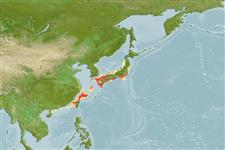Teleostei (teleosts) >
Anguilliformes (Eels and morays) >
Ophichthidae (Snake eels) > Ophichthinae
Etymology: Apterichtus: From the Greek απτερόν (apteron), without fins, and ίχθύς (ichtus, more correctly written ichthys; masculine), fish..
More on authors: Jordan & Snyder.
Environment: milieu / climate zone / depth range / distribution range
Ecology
Marine; demersal; depth range 15 - 240 m (Ref. 101270). Subtropical
Northwest Pacific: Suruga Bay and Kumano-nada Sea in Japan.
Size / Weight / Age
Maturity: Lm ? range ? - ? cm
Max length : 5.0 cm TL (female)
Short description
Identification keys | Morphology | Morphometrics
Vertebrae: 141 - 145. This species is distinguished by the following characters: tail 1.9-2.1, head 14-18, and body depth 53-74 in total length; preopercular pores 3 and pores in supratemporal canal 5 (rarely 6); anterior margin of orbit is above or behind tip of lower jaw; conical teeth, uniserial on jaws and vomer (5 vomerine teeth); body coloration when preserved pale with dark brown or dark orange blotches on preopercle and supratemporal, smaller spots on body and tail, cephalic pores and lateral-line pores in conspicuous pale spots and MVF 66-143, total vertebrae 141-145 (n= 3) (Ref. 101270).
A deepwater species, specimens were captured using dredge and trawl between 111-240 m depth but underwater photographs taken from the sandy bottom at Suruga Bay (Japan) suggest that it might occur as shallow as 15-25 m depth (Ref. 101270).
Life cycle and mating behavior
Maturities | Reproduction | Spawnings | Egg(s) | Fecundities | Larvae
Machida, Y. and S. Ohta, 1994. A new snake-eel, Apterichtus orientalis, from the Pacific coast of western Japan (Opichthinae, Ophichthidae). Jap. J. Ichthyol. 41(1):1-5. (Ref. 13362)
IUCN Red List Status (Ref. 130435)
Threat to humans
Harmless
Human uses
Tools
Special reports
Download XML
Internet sources
Estimates based on models
Phylogenetic diversity index (Ref.
82804): PD
50 = 0.5000 [Uniqueness, from 0.5 = low to 2.0 = high].
Bayesian length-weight: a=0.00089 (0.00039 - 0.00204), b=3.00 (2.80 - 3.20), in cm total length, based on LWR estimates for this (Sub)family-body shape (Ref.
93245).
Trophic level (Ref.
69278): 3.3 ±0.5 se; based on size and trophs of closest relatives
Resilience (Ref.
120179): High, minimum population doubling time less than 15 months (Preliminary K or Fecundity.).
Fishing Vulnerability (Ref.
59153): Low vulnerability (10 of 100).
